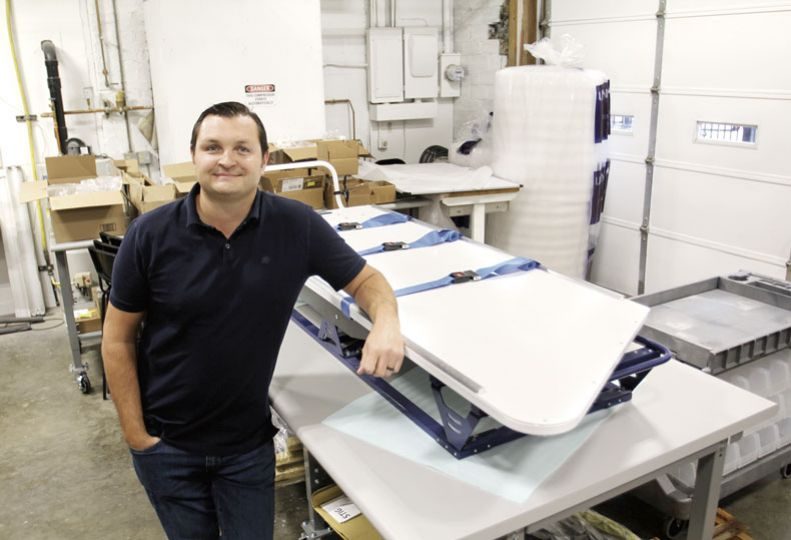
Home » Spokane engineer rolls out new 'backsaver' invention
Spokane engineer rolls out new 'backsaver' invention
Medical device designed to load, unload patients needing air ambulance

September 14, 2023
Spokane-based Critical Airlift Safe Loader LLC has created the Helicopter Air Ambulance Backsaver, a new medical device, to help medical staff reduce injuries and load patients on and off helicopter air ambulances more safely, says the company’s founder, Andy Johnston.
“It increases the speed of critical care to patients and benefits health care workers, because they don’t have to load and unload by hand,” contends Johnston, who is also the owner and principal of Johnston Engineering PLLC, of Spokane.
The HAA Backsaver is designed to attach atop existing hospital-style gurneys awaiting critical helicopter air ambulance patients on medical center rooftops. Using the gurney’s regular pedals, the HAA Backsaver can be adjusted to meet the loading height of a helicopter’s open doors. Next, using the handle controls located at the head of the device, the HAA Backsaver extends to meet the aircraft’s deck, eliminating the slanted gap that patients need to be carried over to be transferred from the aircraft to gurney, says Johnston.
The HAA Backsaver can carry patients weighing up to 575 pounds, reducing offload times and the need for assistance from hospital staff, he adds.
The company received a patent for the all-steel, $36,000 attachment from the U.S. Patent and Trademark Office on June 6, and the device is listed by the U.S. Food and Drug Administration, says Johnston.
“The problem is, people are getting hurt doing this job,” he says. “People in critical-care conditions need to be removed from the helicopter or put back on the helicopter (quickly) where literally every second counts. If it wasn’t a big deal, they couldn’t be flying on a helicopter in the first place.”
Most patients exceed the safe lifting maximus recommend by the Occupational Safety and Health Administration recommends, says Johnston.
According to the National Association of Emergency Medical Technicians, 1 in 4 emergency medical services workers will suffer a career-ending back injury within the first four years of service.
Back injury costs, including medical bills, wage loss, and benefits, average between $40,000 and $80,000, according to OSHA data. The average worker’s compensation settlements for lower back injuries were valued at $37,000, reports the National Council of Compensation Insurance.
Johnston hasn’t yet sold the medical device to hospitals but plans first to approach Providence and MultiCare Health System Inc., in Spokane.
He has identified 6,000 potential locations where HAA Backsaver could be used across the country, a $216 million potential market. Eventually, Johnston will look to market the device in Canada.
The HAA Backsaver was developed by Johnston Engineering, a product development engineering firm that specializes in prototype design and fabrication, engineering design, and analysis for customers who want to bring their products from concept to market. The firm has designed products for aerospace, pharmaceutical, food and beverage, and electrical power generation and distribution, among other fields.
Johnston’s company, Critical Airlift Safe Loader, that he formed for the HAA Backsaver, doesn’t yet have a physical location and currently is operating out of his firm’s headquarters at 1815 E. Trent, in Spokane’s East Central neighborhood.
While most products the size of the HAA Backsaver take about 1 1/2 years to develop and bring to market, Johnston says the HAA Backsaver took almost five years, because it was a side project that the firm worked on during down times.
The idea for the product came from a helicopter air ambulance pilot who had witnessed injuries ranging from damaged knees to a devastating back injury sustained by hospital staff and emergency helicopter air ambulance personnel and wanted to create a product that would mitigate the issue. Johnston Engineering took on the design and created a prototype that was tested at a hospital setting. Eventually, the pilot didn’t want to continue with the development and stepped away from the project, and Johnston Engineering purchased the intellectual property rights from him.
“We’ve been growing, so we’ve been very busy and working on other projects,” he says. “This has been a long process for us because we use this as filler work.”
The HAA Backsaver is intended to stay on the roof of hospitals and provide swift loading and unloading of patients who are in critical care, including drivers in vehicle accidents, heart attacks, life-altering trauma from farming accidents, intracranial bleeding, or burns requiring treatment in a burn center.
“Even if this saves one patient’s life, which seems like that would be worth it for hospitals,” says Johnston. “If it saves two people from a back sprain that would be worth it economically from the hospital’s (perspective).”
Latest News Special Report Health Care Technology
Related Articles
Related Products




![Brad head shot[1] web](https://www.spokanejournal.com/ext/resources/2025/03/10/thumb/Brad-Head-Shot[1]_web.jpg?1741642753)
